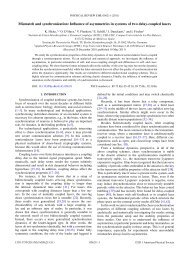DBI Analysis of Open String Bound States on Non-compact D-branes
DBI Analysis of Open String Bound States on Non-compact D-branes
DBI Analysis of Open String Bound States on Non-compact D-branes
Create successful ePaper yourself
Turn your PDF publications into a flip-book with our unique Google optimized e-Paper software.
CHAPTER 6. SETTING 80with r ∈Ê+, 0 ≤ θ ≤ π 2and 0 ≤ φ, ψ ≤ 2π, c<strong>on</strong>sidering the double scaling limitg s ,ρ 0√α ′ρ 0g s√α ′−→ 0, (6.4)= c<strong>on</strong>stant, (6.5)and performing a T-duality al<strong>on</strong>g the angular φ directi<strong>on</strong>, <strong>on</strong>e is left with the geometry⎧[ ( ) dω 2 ( ) ]dω2⎪⎨ ds 2 = dx µ dx µ + α ′ k dr 2 + coth 2 k + dψ + dθ 2 + tan 2 θ ,k(6.6)⎪⎩ e 2Φ = g2 eff 1k sh 2 r cos 2 θ ,with k the number <str<strong>on</strong>g>of</str<strong>on</strong>g> NS5-<strong>branes</strong>, ω the T-dual coordinate to φ, and g eff given by√kα ′g eff = e Φ 0. (6.7)ρ 0Note that the Kalb-Ram<strong>on</strong>d field has vanished. Further note that although we nowfind ourselves with three <strong>compact</strong> dimensi<strong>on</strong>s (θ, φ and ψ), we did not <strong>compact</strong>ify anydimensi<strong>on</strong>. All we did was introduce a change <str<strong>on</strong>g>of</str<strong>on</strong>g> coordinates, just like <strong>on</strong>e could reachany point <strong>on</strong> the flat (x, y)-plane by specifying an angle and a radius. By introducingsuch a <strong>compact</strong> coordinate, <strong>on</strong>e does not <strong>compact</strong>ify a dimensi<strong>on</strong>.It is worth pauzing an extra sec<strong>on</strong>d at this, since this is exactly what sets this approachapart from the Kaluza-Klein-like approach where <strong>on</strong>e does <strong>compact</strong>ify a dimensi<strong>on</strong>in order to make it invisible (or more precisely: make the physics in that dimensi<strong>on</strong>decouple from the physics in the other dimensi<strong>on</strong>s). We do not <strong>compact</strong>ify, but c<strong>on</strong>sidera setting in which states appear that are fixed in some dimensi<strong>on</strong>, limiting their freedom<str<strong>on</strong>g>of</str<strong>on</strong>g> movement to the remaining dimensi<strong>on</strong>s, thereby from a physical point <str<strong>on</strong>g>of</str<strong>on</strong>g> view makingthe “static” dimensi<strong>on</strong> “invisible.”The bracketed part <str<strong>on</strong>g>of</str<strong>on</strong>g> the geometry described by Eq. 6.6 can be decomposed as thedirect product <str<strong>on</strong>g>of</str<strong>on</strong>g> two two-dimensi<strong>on</strong>al geometries. One is the bell,⎧⎨ds 2 = α ′ k [ dθ 2 + tan 2 θ dω 2] ,⎩e 2Φ = g2 effcos 2 θ , (6.8)and the other is the trumpet,⎧⎨ds 2 = α ′ k [ dr 2 + coth 2 r dψ 2] ,⎩e 2Φ = e2Φ 0sh 2 r . (6.9)We will not be c<strong>on</strong>cerned by the six-dimensi<strong>on</strong>al Minkowski and two-dimensi<strong>on</strong>al bellgeometries, as the physics in these geometries is already quite well understood. Weinstead focus <strong>on</strong> what happens in the trumpet.
















